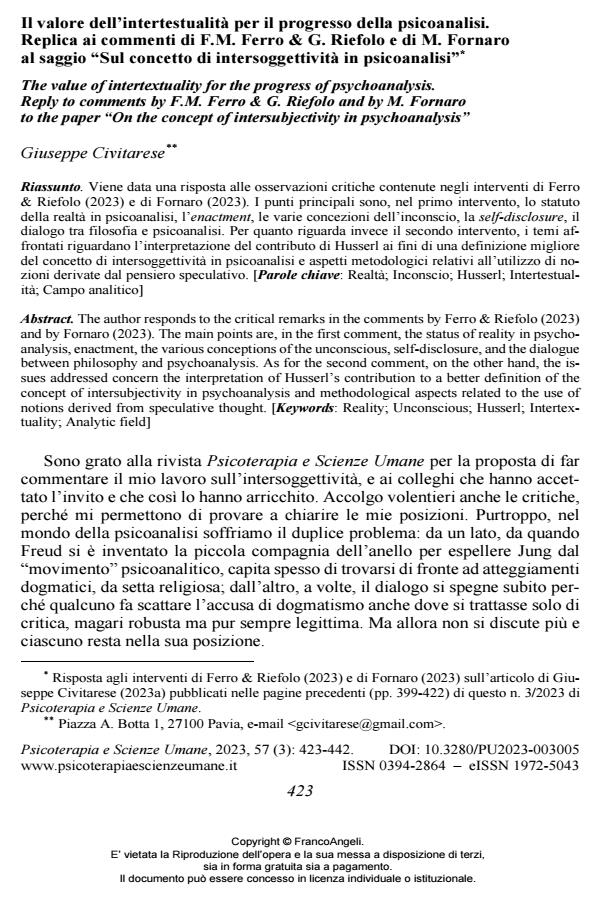The value of intertextuality for the progress of psychoanalysis. Reply to comments by F.M. Ferro & G. Riefolo and by M. Fornaro to the paper "On the concept of intersubjectivity in psychoanalysis"
Journal title PSICOTERAPIA E SCIENZE UMANE
Author/s Giuseppe Civitarese
Publishing Year 2023 Issue 2023/3
Language Italian Pages 20 P. 423-442 File size 124 KB
DOI 10.3280/PU2023-003005
DOI is like a bar code for intellectual property: to have more infomation
click here
Below, you can see the article first page
If you want to buy this article in PDF format, you can do it, following the instructions to buy download credits

FrancoAngeli is member of Publishers International Linking Association, Inc (PILA), a not-for-profit association which run the CrossRef service enabling links to and from online scholarly content.
The author responds to the critical remarks in the comments by Ferro & Riefolo (2023) and by Fornaro (2023). The main points are, in the first comment, the status of reality in psycho- analysis, enactment, the various conceptions of the unconscious, self-disclosure, and the dialogue between philosophy and psychoanalysis. As for the second comment, on the other hand, the is- sues addressed concern the interpretation of Husserl’s contribution to a better definition of the concept of intersubjectivity in psychoanalysis and methodological aspects related to the use of notions derived from speculative thought.
Keywords: Reality; Unconscious; Husserl; Intertex- tuality; Analytic field
- Intersoggettività: questa sconosciuta. Controreplica a Civitarese Mauro Fornaro, in PSICOTERAPIA E SCIENZE UMANE 3/2023 pp.443
DOI: 10.3280/PU2023-003006 - Essere o non essere Habermas. Una risposta alla controreplica di Mauro Fornaro Giuseppe Civitarese, in PSICOTERAPIA E SCIENZE UMANE 3/2023 pp.449
DOI: 10.3280/PU2023-003007
Giuseppe Civitarese, Il valore dell’intertestualità per il progresso della psicoanalisi. Replica ai commenti di F.M. Ferro & G. Riefolo e di M. Fornaro al saggio "Sul concetto di intersoggettività in psicoanalisi" in "PSICOTERAPIA E SCIENZE UMANE" 3/2023, pp 423-442, DOI: 10.3280/PU2023-003005